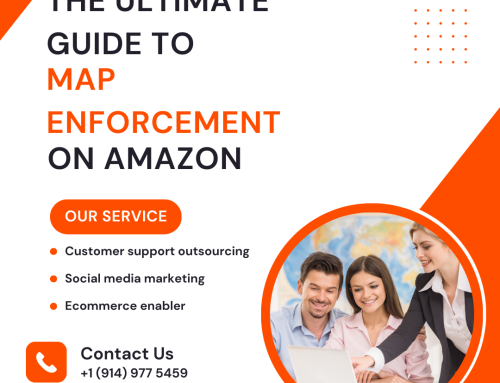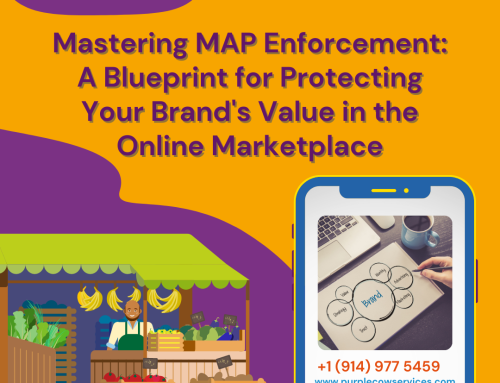Ensuring consistent and fair pricing is more than just a good business practice when selling on Amazon; it's an absolute necessity.
Share This Story, Choose Your Platform!
In the highly competitive world of e-commerce, business owners must familiarize themselves with the critical concepts of brand integrity and perception. One significant challenge that sellers encounter is the Minimum Advertised Price (MAP) violation.
A MAP violation might seem like a minor hiccup, but in reality, it can have severe repercussions for your business. Such violations can quickly erode trust among your customers, devalue your brand, and create unnecessary complexities within the market. So, if you’re an Amazon seller who collaborates with various resellers, you need to understand how to not only identify MAP violations but also respond effectively and, more importantly, prevent them from happening in the first place.
What Is a MAP Violation?
To address the issue of MAP violations effectively, let’s begin by defining what exactly a MAP violation entails. A MAP violation occurs when a retailer advertises a product at a price lower than the minimum price set by the manufacturer. In essence, it’s a breach of the agreed-upon pricing standards that are crucial for maintaining a level playing field among sellers.
The Significance of Knowing MAP Policy Violations
The importance of understanding MAP policy violations cannot be overstated. Pricing is a critical aspect of your brand’s image, and any deviations from the agreed-upon standards can have far-reaching consequences. By familiarizing yourself with the significance of MAP violations, you can align your strategies with your desired brand perception, ultimately benefiting your business in several ways.
Healthy Competition
In the world of online shopping, consumers are constantly comparing prices across different platforms to secure the best deals. While some shoppers may be solely focused on finding the lowest prices, not all consumers share the same perspective. Many value quality, authenticity, and the overall brand experience over rock-bottom prices. As a seller who abides by MAP policies, you can leverage this to your advantage.
Protected Profit Margins
Frequent undercutting of prices can diminish profit margins for both manufacturers and retailers. Recognizing MAP violations and taking action against them can help protect these margins, ensuring that your business remains economically viable and sustainable in the long run.
Strengthened Relationships
Brand owners rely heavily on their distribution channels. When distributors or unauthorized sellers operate outside the boundaries set by MAP policies, it can lead to a breakdown in trust and loyalty. This, in turn, negatively impacts the brand’s partner network. However, when MAP policies are consistently enforced, all retailers adhere to the same pricing standards, fostering trust and promoting lasting partnerships between brands and retailers.
The Important Scopes of MAP Policy
To effectively combat MAP violations, it’s crucial to understand the specific areas covered by MAP policies. This knowledge allows you to accurately identify violations and take appropriate action. The key aspects of MAP policy include:
Listing Price
The listing price is the price displayed to potential buyers. Some sellers may display a price that is lower than the minimum advertised price on their website or platform. This clear breach of the policy can quickly tarnish a brand’s reputation.
Shipping
Some sellers may offer deals like “buy one, get free shipping,” which may seem harmless at first glance. However, if the effective price (which includes the product price and shipping cost) falls below the minimum advertised price, it constitutes a violation of the policy.
Discounts
Sellers may provide additional discounts at checkout or use coupon codes to lower the final price below the minimum advertised price. While the listed price might comply with the policy, the final price does not, making this a sneaky way to sidestep the rules.
Bundles
Offering multiple products together at a discounted rate is a common practice. However, if the total price of the package exceeds the minimum advertised price within that bundle, it constitutes a violation of the policy.
How To Identify a MAP Violation Effectively
Given the vast and complex nature of online marketplaces, identifying MAP violations can be a daunting task. However, it’s a crucial aspect of maintaining brand integrity and protecting your business. Here are some effective methods to help you track and identify MAP violations:
Delegate MAP Violation Tracking Solutions
Attempting to track MAP violations manually is not only time-consuming but also prone to errors. To streamline the process, consider utilizing reliable tracking tools that automate the monitoring of multiple online platforms. These specialized solutions can continuously scan for violations, monitor prices, and ensure that they comply with MAP guidelines. They also provide real-time alerts when potential violations are detected, generate comprehensive reports that detail the nature, frequency, and sources of discrepancies, and offer visual representations, such as graphs and charts, to facilitate data analysis.
Create a Warning Policy
To address MAP violations effectively, it’s important to have a clear and fair warning policy in place. Start with a soft warning for first-time offenders who may have unintentionally violated the rules due to misunderstandings. This initial alert allows them to correct their actions and seek clarification if needed. However, if a seller continues to make the same mistakes after receiving the initial warning, it may indicate a deliberate disregard for your policies. In such cases, the warnings can become progressively tougher, sending a clear message that your business takes MAP policy violations seriously.
The Best Response to MAP Violators
Dealing with sellers who violate MAP policies can be a challenging and potentially overwhelming task, especially when you’re juggling various aspects of your business operations. However, there is an ideal approach to handling such situations effectively and professionally. One of the most effective responses to MAP violators is to communicate through a well-drafted letter.
How to Draft an Effective Letter
When addressing MAP violators, it’s essential to craft a letter that communicates your brand’s value and commitment clearly. Here’s how to draft an effective letter:
Clearly State Your Intent: Begin the letter by clearly stating your intent, which is to address the violation and seek resolution.
Use Evidence: Provide evidence of the violation, including specific dates, product listings, and screenshots. This evidence is not meant to confront the seller but to inform them of the violation.
Highlight the MAP Policy: Emphasize the content of your MAP policy and provide the seller with a copy if necessary. Ensure that they are fully aware of the policy’s terms.
Allow Room for Explanation: Provide the seller with an opportunity to explain their actions or ask questions. It’s important to maintain open lines of communication.
Conclude with Optimism: Conclude the letter on a positive note, expressing hope that such violations won’t recur in the future.
Follow Up: After sending the letter, follow up with the seller to ensure that they have taken corrective measures or responded to your message. This proactive approach demonstrates your commitment to enforcing your MAP pricing policy and maintaining the integrity of your brand.
Tips to Remember:
Your MAP pricing policy serves as the cornerstone of your business. It’s not something to be taken lightly. By addressing violations promptly and professionally, you not only protect your brand but also ensure a fair and competitive marketplace for all.
More Ways to Prevent MAP Violations
While having a robust MAP policy in place is crucial, effective implementation and proactive measures can further help prevent MAP violations. Here are additional strategies to consider:
Consult Legal Counsel:
Before finalizing your MAP policy, seek advice from legal experts who specialize in e-commerce and pricing regulations. They can provide valuable insights into the best way to word your policy and how to enforce it legally, ensuring that your brand is fully protected.
Adjust the Policy As Needed:
The e-commerce market is dynamic and ever-changing, with pricing strategies evolving over time. Regularly review and adjust your MAP policy to align with current market conditions. Staying adaptable allows you to maintain effective brand protection.
Strengthen Distribution Channels:
Choose your distributors and authorized resellers carefully. Implement stringent criteria for selecting partners who prioritize brand protection. By ensuring that your products are distributed through reliable channels, you can significantly reduce the chances of them ending up in the hands of unauthorized sellers who might violate your MAP policy.
Encourage Consumer Awareness:
Educate your customers about the potential risks associated with purchasing from gray market sellers or unauthorized resellers. These risks may include receiving counterfeit goods, lack of warranties or customer support, and potential safety concerns. Informed consumers are more likely to make purchases from authorized and trusted sources.
Communicate the Policy:
Ensure that everyone involved in your distribution chain, including distributors, retailers, and resellers, is fully aware of your MAP policy. Clear communication is key to ensuring that all parties understand the importance of adhering to minimum advertised prices.
Brand Protection Is at Seller Interactive’s Hands
Protecting your brand’s reputation and maintaining its integrity is a top priority, especially in the competitive and sometimes unpredictable e-commerce landscape. A single misstep, such as a MAP violation, can tarnish the reputation you’ve painstakingly built. It can erode the essence of your business—its trustworthiness, reliability, and value proposition—in an instant.
That’s where Seller Interactive comes into play. Our dedicated team specializes in brand protection and management across various online platforms, including Amazon. We diligently monitor your listings to identify and address potential violations, such as hijackers or counterfeiters, that could damage your online presence.
With Seller Interactive on your side, you can trust that your business is in capable hands. We understand the importance of enforcing your MAP pricing policy and protecting your brand’s integrity. Whether you’re a new seller or an established brand, we provide the expertise and support you need to safeguard your reputation and thrive in the competitive world of e-commerce.
Don’t leave your brand’s reputation to chance. Trust the online selling professionals at Seller Interactive. Book a call with us today to discover how we can help you go from surviving to thriving on Amazon and other e-commerce platforms.
Conclusion:
Understanding, identifying, responding to, and preventing MAP violations is crucial for any business operating in the e-commerce space. By adhering to a well-crafted MAP policy and implementing proactive measures, you can protect your brand’s integrity, maintain fair pricing, and foster trust among your customers and partners. Seller Interactive stands ready to assist you in this endeavor, ensuring that your business not only survives but thrives in the competitive world of online retail.
Safeguard Your Brand with Purple Cow: MAP Violations, be gone! Our expert team at Purple Cow specializes in protecting your brand’s integrity on e-commerce platforms. We detect, respond, and prevent MAP violations, ensuring your pricing stays fair and competitive. Don’t let your brand’s reputation be tarnished—trust Purple Cow for brand protection that goes beyond the ordinary. Secure your brand’s success today!
Share This Story, Choose Your Platform!
In This Blog:

















